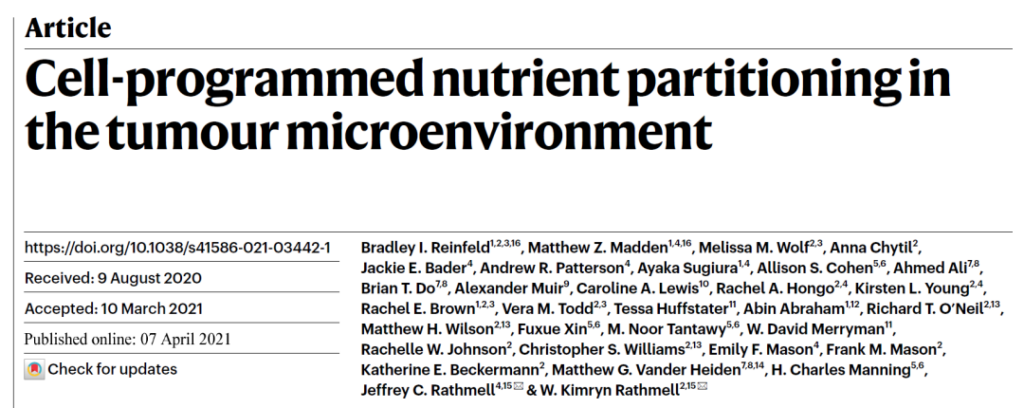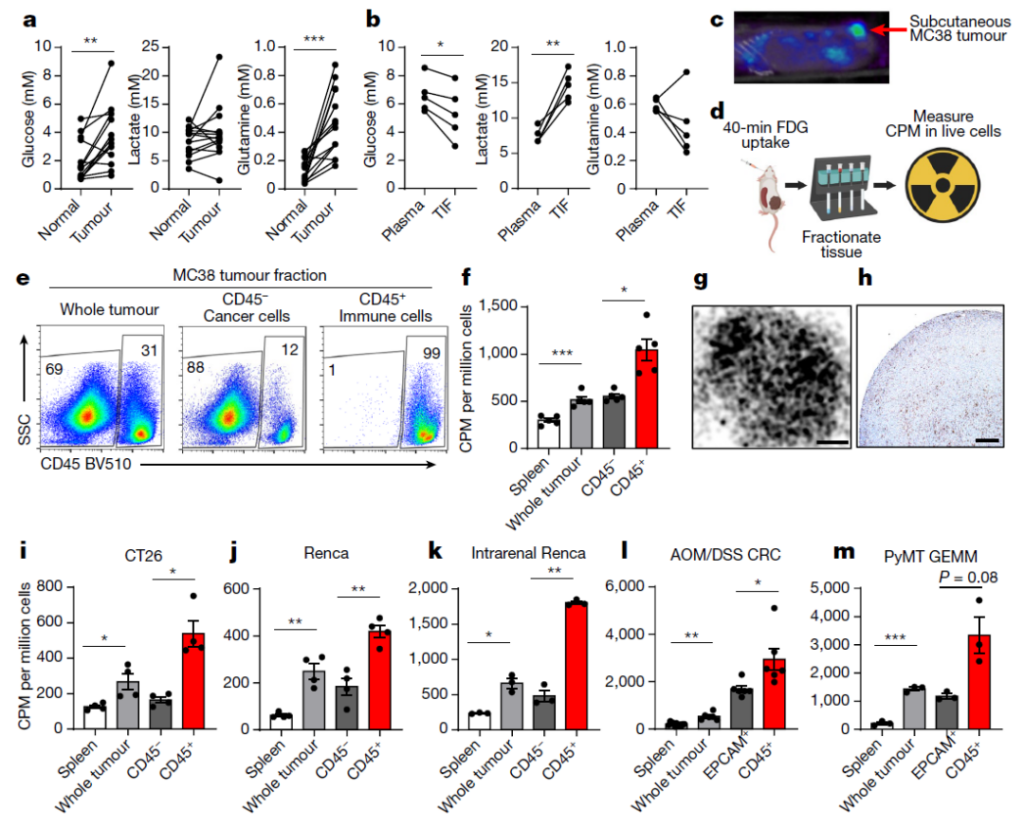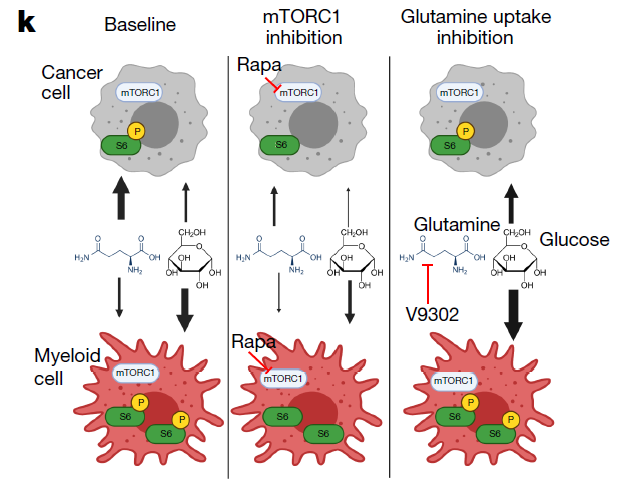Not cancer cells that crazely consume nutrients in tumors
- Normal Liver Cells Found to Promote Cancer Metastasis to the Liver
- Nearly 80% Complete Remission: Breakthrough in ADC Anti-Tumor Treatment
- Vaccination Against Common Diseases May Prevent Dementia!
- New Alzheimer’s Disease (AD) Diagnosis and Staging Criteria
- Breakthrough in Alzheimer’s Disease: New Nasal Spray Halts Cognitive Decline by Targeting Toxic Protein
- Can the Tap Water at the Paris Olympics be Drunk Directly?
Not cancer cells that crazely consume nutrients in tumors
Not cancer cells that crazely consume nutrients in tumors. Overturn the century-old cognition of cancer: It is not cancer cells that consume nutrients crazy in tumors, but immune cells.
In the cell, there are two ways of sugar metabolism: mitochondrial oxidative phosphorylation and glycolysis. In normal mammalian cells, glycolysis is inhibited under aerobic conditions. Glycolysis is a process in which glucose or glycogen in cells is decomposed into lactic acid under anaerobic or hypoxic conditions, and a small amount of ATP is produced at the same time. This way of sugar metabolism without oxygen is very fast, but it will cause a lot of energy in glucose to be wasted.
However, in 1921, German scientist Otto Warburg observed a strange phenomenon: cancer cells consume glucose at a very high rate, and their glycolysis is extremely active, even under conditions of sufficient oxygen, cancer cells are as active as glycolysis. . This type of glycolysis of cancer cells in an aerobic state is also called the “Warburg effect.” Otto Warburg also won the Nobel Prize in Physiology or Medicine in 1931 for discovering cellular respiration oxidase transferase.
In recent years, the field of cancer metabolism has exploded, but these are based on the discovery of Otto Warburg 100 years ago: cancer cells consume glucose at a very high rate. Over the past 100 years, many scientists have put forward various conjectures to try to explain this peculiar phenomenon. For example, some people believe that it is caused by abnormal mitochondrial function of cancer cells. However, follow-up studies have shown that the mitochondrial function of most cancer cells is not impaired.
On April 7, 2021, researchers from Vanderbilt University Medical Center in the United States published a research paper titled: Cell-programmed nutrient partitioning in the tumour microenvironment in the top international academic journal Nature.
This study shows that the culprit of the tumor’s high-speed consumption of glucose is not cancer cells, but non-cancer cells in tumor tissues-macrophages and other immune cells. This discovery has overturned the cancer metabolism model developed and perfected over the past 100 years and people Basic knowledge of cancer.
The research team said that different types of cells in the tumor microenvironment consume different nutrients according to their metabolic procedures. This discovery can be used to develop new cancer therapies and imaging strategies.

The Warburg effect is the basis of positron emission tomography (PET) imaging of tumor tissues. It uses a glucose radiotracer (FDG) to “illuminate” cancer cells according to their glucose metabolism, thereby accurately locating cancer cells And organization. However, FDG-PET does not always provide the results that clinicians expect.
Kimryn Rathmell, the corresponding author of the paper and director of the Department of Medicine at Vanderbilt University, said: “For many years, I have been curious about the results of PET scans. According to my biological experience, the kidney cancer I am studying should be in PET scans. It is highlighted in the scanning imaging, however, in fact it is not bright in most cases.”
Now, we already know that tumor tissues are not all cancer cells, but also many types of other cells, such as immune cells. Therefore, Kimryn Rathmell and others began to think about a question: Is it not tumor cells that consume glucose at a high speed in tumors? As a result, the PET imaging is inaccurate?
To verify this question, Bradley Reinfeld of Kimryn Rathmell’s research group and Matthew Madden of Jeff Rathmell’s research group conducted further research.

From left to right: Kimryn Rathmell, Bradley Reinfeld, Matthew Madden, Jeffrey Rathmell
Their research method is simple: use PET tracer on mice with tumors, then separate the tumor tissues, use cell surface marker proteins and flow cytometry to divide the tumors into various cell types, and then detect the radioactivity in the cells.
They used two different PET tracers, one for tracking glucose and the other for tracking glutamine, and used six different tumor models including colorectal cancer, kidney cancer, and breast cancer. Verified in. The results showed that in each case, myeloid immune cells (mainly macrophages) absorbed the most glucose, followed by T cells and cancer cells. On the contrary, cancer cells absorbed the most glutamine. It shows that this situation is common in different types of tumors.

The research team further discovered that the absorption of glucose and glutamine differs in different cell types, not because of the lack of these nutrients, but because of specific signaling pathways.

For 100 years, people have always believed that there is metabolic competition between cancer cells and immune cells in the tumor microenvironment, and cancer cells can consume glucose at a high speed, resulting in immune cells not being able to obtain enough glucose, and thus unable to play the role of killing cancer cells.
However, this study clearly shows that the supply of nutrients in tumor tissues is not restricted. In fact, cells are programmed to consume specific nutrients, and there is a nutrient distribution mechanism: cancer cells absorb glutamine and fatty acids, and immune cells absorb glucose.
This study confirmed that the culprit of the tumor’s high-speed consumption of glucose is not cancer cells, but non-cancerous cells in tumor tissues—macrophages and other immune cells, which overturned the cancer metabolism model developed and perfected over the past 100 years and people’s perception of cancer. Basic cognition.
More importantly, this study revealed that different cells in the tumor microenvironment tend to absorb different nutrients, which helps to further develop specific targeted therapies and also explains the inaccurate results of FDG-PET imaging. , Pointed out the direction for the development of new PET imaging technology.
(source:internet, reference only)
Disclaimer of medicaltrend.org



